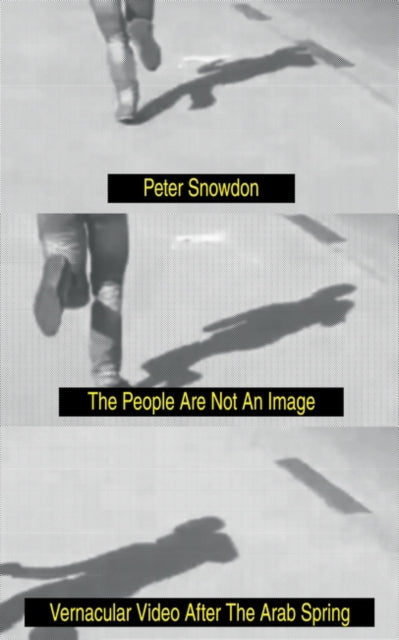Peter Snowdon
People Are Not an Image: Vernacular Video After the Arab Spring
People Are Not an Image: Vernacular Video After the Arab Spring
- Condition: Brand new
- UK Delivery times: Usually arrives within 2 - 3 working days
- UK Shipping: Fee starts at £2.39. Subject to product weight & dimension
Bulk ordering. Want 15 or more copies? Get a personalised quote and bigger discounts. Learn more about bulk orders.
Couldn't load pickup availability
- More about People Are Not an Image: Vernacular Video After the Arab Spring
The wave of uprisings and revolutions that swept the Middle East and North Africa between 2010 and 2012 was most vividly transmitted throughout the world not by television or even social media, but in short videos produced by the participants themselves and circulated anonymously on the internet. In The People Are Not An Image, Snowdon explores this radical shift in revolutionary self-representation, showing that the political consequences of these videos cannot be located without reference to their aesthetic form.
Format: Hardback
Length: 304 pages
Publication date: 29 September 2020
Publisher: Verso Books
Between 2010 and 2012, a wave of uprisings and revolutions swept across the Middle East and North Africa, leaving an indelible mark on global politics. While television and social media played significant roles in transmitting these events, it was the anonymous circulation of short videos produced by the participants themselves that truly captured the essence of the movements. In his book, The People Are Not An Image, author and photographer Edward Snowdon delves into this transformative shift in revolutionary self-representation.
Snowdon argues that the political consequences of these videos cannot be understood without considering their aesthetic form. By examining videos from Tunisia, Bahrain, Syria, Libya, and Egypt, he closely analyzes the circumstances surrounding their production and circulation. Drawing on a wide range of historical and theoretical material, Snowdon seeks to uncover what these videos can tell us about the potential for revolution in our time and the possibilities of video as a truly decentralized and vernacular medium.
One of the key insights that Snowdon explores is the role of technology in shaping the nature of these movements. He notes that the widespread availability of smartphones and social media platforms allowed participants to capture and share their experiences in real time, bypassing traditional media outlets and enabling a more direct and intimate connection between the revolutionaries and their supporters. This, in turn, facilitated the spread of information and the building of collective identities among the participants.
Another important aspect of Snowdon's analysis is the way in which these videos challenged traditional notions of power and authority. He observes that the participants in these movements often used video to challenge the narratives propagated by the ruling elites and to expose the injustices and abuses that they had been subjected to. By doing so, they were able to mobilize support and inspire others to join their cause, creating a sense of urgency and momentum that was difficult for the authorities to suppress.
Snowdon also explores the political implications of these videos beyond the immediate context of the uprisings and revolutions. He argues that the widespread circulation of these videos has had a significant impact on the global political landscape, shaping public opinion and influencing the actions of governments and international organizations. For example, the video of Mohamed Bouazizi's self-immolation in Tunisia sparked a wave of protests and rebellions across the Arab world, leading to the overthrow of several authoritarian regimes and the emergence of new political movements.
In conclusion, The People Are Not An Image is a thought-provoking and insightful book that offers a fresh perspective on the recent wave of uprisings and revolutions in the Middle East and North Africa. By examining the role of short videos in shaping these movements, Snowdon challenges our understanding of power, authority, and the potential for revolution in our time. Through his meticulous analysis and compelling storytelling, he provides a valuable contribution to our understanding of the complex and evolving political landscape of the region.
Weight: 350g
Dimension: 154 x 233 x 23 (mm)
ISBN-13: 9781788733168
This item can be found in:
UK and International shipping information
UK and International shipping information
UK Delivery and returns information:
- Delivery within 2 - 3 days when ordering in the UK.
- Shipping fee for UK customers from £2.39. Fully tracked shipping service available.
- Returns policy: Return within 30 days of receipt for full refund.
International deliveries:
Shulph Ink now ships to Australia, Belgium, Canada, France, Germany, Ireland, Italy, India, Luxembourg Saudi Arabia, Singapore, Spain, Netherlands, New Zealand, United Arab Emirates, United States of America.
- Delivery times: within 5 - 10 days for international orders.
- Shipping fee: charges vary for overseas orders. Only tracked services are available for most international orders. Some countries have untracked shipping options.
- Customs charges: If ordering to addresses outside the United Kingdom, you may or may not incur additional customs and duties fees during local delivery.


